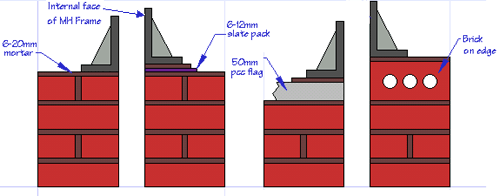I need some advice. I have an old drain access cover that is bricklined (dimensions to outside of brick about 680 x 900). The cover is old, heavy, but loose. The hole is a couple of metres outside a stable door. I want to replace the cover and make it safer. The brickwork is surrounded on 3 sides by concrete and level with it. I would like everything flush.
Looking down the building supplies it seems my best recourse is to knock out the topic layer of bricks and place a concrete pre-made heavy duty frame which fits about perfect. Then get a heavy duty standard sized cover to fit. All this comes to about £100 and will be nearly flush (the frame is a bit deeper than a brick course).
Is this a ok idea and if so how should I lay the concrete frame - just ordinary mortar on top of the brick ?
Thanks
Chris
If th
odd size drain cover
-
99-1093880114
-
84-1093879891
Yes, you can remove courses of brick as required to accommodate the new cover, and then bed that on a Class II mortar but not more than 20mm thick. If your mortar bedding would need to be be more than 20mm deep, then you could use some form of inert packing material (roofing slate is a favourite) to take up the slack, or adjust the course below, as shown in this illustration...

...which shows 4 different seating options, each giving a slightly different finished height for the MH frame. Once you know the level at which you need to set the frame, you can choose the best option for you. It may be that you need to combine a couple of the methods shown below; for instance, if the MH cover is to be set to matching the slope of an existing pavement, then the lower edge might be sat on a mortar bed, with the higher edge 'packed up' on slate or concrete roof tile, and the two sloping edges, packed to suit with inert material.
The golden rules are that no mortar bed should be more than 20mm (and we prefer not more than 15mm) and that any packing material must be strong in compression and inert, so no using bits of wood or cardboard! :)

...which shows 4 different seating options, each giving a slightly different finished height for the MH frame. Once you know the level at which you need to set the frame, you can choose the best option for you. It may be that you need to combine a couple of the methods shown below; for instance, if the MH cover is to be set to matching the slope of an existing pavement, then the lower edge might be sat on a mortar bed, with the higher edge 'packed up' on slate or concrete roof tile, and the two sloping edges, packed to suit with inert material.
The golden rules are that no mortar bed should be more than 20mm (and we prefer not more than 15mm) and that any packing material must be strong in compression and inert, so no using bits of wood or cardboard! :)
-
99-1093880114